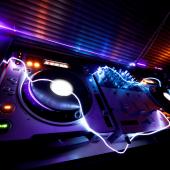Light Jockeys
Good club light is an art in itself. Beeing a light jockeys requires musical sensitivity, sense of rhythm, a sense of colour and extensive knowledge of the music style and the audience, which dances to it.
Each club has its own lighting concept. Greater discos more often dependent on a professional light jockey than small clubs. Where earlier without a light man not much was possible, nowadays one increasingly uses saved light patterns or via sound-to-light an automatic light show. Alternatively, one can book a video artist to enrich the flyer.
However, it is just the case that no machine can capture the atmosphere of the music and the mood on the dancefloor that well as if a light jockey amplifies the light live. One may here argue about the tastes. One light jockey prefers a rather bright light, the other one tends to darker tones. The colours and effects are more or less a matter of taste. However, the timing is what matters. It is probably the common goal of all light jockeys, to create a unit from the music and the light and thus to create the perfect atmosphere on the dancefloor.
The term light jockey originated in the disco scene at the end of the 80s, when the first complex lighting controller came on the market, which had become possible for digital control of lighting by introducing the DMX technology in 1986. The rapidly progressing development of increasingly complex lighting and control technologies required a professional operation of lighting consoles. One of the most famous and still widespread lighting consoles of the DMX Generation is the "Masterpiece" from Pulsar. The company even has been conducting international light show contests to crown the best LJ.
Even if light jockeys usually stand in the shadow next to the DJ - they focus on an important job in the operation of the club and play an important role for the right atmosphere on the dancefloor.




